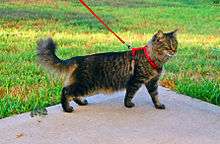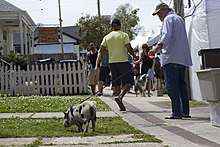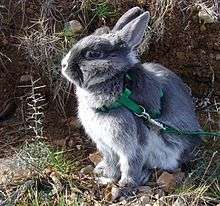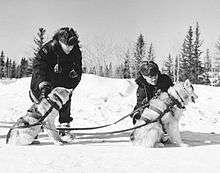Pet harness

A pet harness is equipment consisting of straps that loop nearly around—that fasten together using snap-fit buckles—the back of a companion animal, such as a dog, pig, rabbit, ferret, rodent, or, occasionally, a cat, that is generally similar to harness tack for horses. Also, harnesses specifically made to fit a parrot’s anatomy are manufactured; see parrot harness. They are most often used to simply restrain an animal, having a ring suitable for a leash to clip to, but dogs may also particularly wear them to assist to a person with a disability, haul a cart or sled, or pull a human being, such as in skijoring or pulka.
Pet harnesses

Many harnesses are made of nylon, and some harnesses are size-adjustable. There are various designs, some with straps in the form of an X, while others are in the form of a sideways H. The original purpose of pet harnesses was to pull weight or to mount tools or alerting signs on them; however, while they are still used for this, they are now commonly used to restrain an animal, such as a dog who has a tendency to run away that is taken outside for a walk. When used as such, the harness is worn in conjunction with a leash; one end of the leash has a clip that is attached to a ring on the harness, while the other end is typically a loop held by the person. While a collar only encircles the neck, H-style harnesses have loops that also surround the torso, with connecting straps between them for reinforcement. This design allows for distribution of force, which may: prevent choking the animal if it pulls the leash, and have a lower chance of the animal slipping out than is possible if it wears a collar.


The choking neck and girth harnesses limited the ability of draft animals to exert themselves, therefore, in order to eliminate this problem, they were replaced by chest strap harnesses. Harness usage is growing in popularity among many pet owners − especially for those with smaller breed dogs. Recently, pet clothing frequently sports a properly-placed buttonhole for hooking a leash to the harness worn under the garment. Nowadays, dog harnesses are used – even as high visibility vest – for walking, rehabilitation of injured dogs, swimming – as swimming vests –, rescue – as rappelling or carrying harnesses – and mounting of texts and signs.
Also available are dog harnesses designed to look like clothes and reduce the stress placed on a small dog's neck while walking on a leash.[1]
Sled dog harnesses
Sled dog harnesses vary depending on whether the dog is hauling freight or racing. Harnesses come in three main types: the freight harness, the H-back harness, and the X-back harness. Dog sports are growing and more types of harnesses are being developed, including the Y-back style and guard or distance harness. This type of harness is quickly becoming a favorite for those who enjoy skijoring.
The freight harness, often an H-back harness with a wide chestband and sometimes extra padding, is designed to help the dog pull heavy weights efficiently, and may feature a spreader bar behind the wheel dogs and before the sled or cart. The straps form an 'H' or ladder-like effect across the back of the dog. These harnesses help distribute the weight of the cargo over a broader body area.

Racing harnesses are lighter and shorter than freight harnesses. The X-back harness, so called because the straps form an 'X' across the back of the dog, is used more frequently than the H-back, with short versions that ride farther forward on the dog's body recently gaining in popularity.
The Y-back or hybrid harness is similar in appearance to the H-back. The tugline attaches to the harness on top of the dog's back and stretches parallel to the ground or upwards to the skier, bicycle, or other load.
In contrast, dogs that participate in weight pulls (as compared to a regular freight harness) will wear very heavy, padded harnesses, with broad chestbands to help spread the weight and prevent harm to the dog.
Dog training harnesses
Harnesses are not only good dog handling tools, as they are also used for training. There are a variety of dog training harnesses, usually made of nylon or leather. Both of these materials are perfect for this purpose. Commonly, nylon harnesses are cheaper than leather ones. There are specially designed harnesses with fully padded chest plate for agitation, protection and attack training.[2] The chest plate absorbs the shock during the hit, thus preventing serious injuries to the dog. This is especially vital for those dogs who are trained on daily basis.
Assistance dog harnesses
Assistance dogs may wear specialized harnesses, although not required by the Americans with Disabilities Act. Mobility assistance dogs may wear specialized, custom-designed harnesses that allow them to bear a small portion of their handlers’ weight so that they may offer balance assistance, counterbalance, bracing and stability. These harnesses usually include a rigid metal bracing handle, but some include lightweight soft handles to allow for minor support. Guide dogs work in specially designed harnesses which allow the dog to communicate properly with the handler while leading. A handle of a guide dog harness is different than that of a mobility assistance dog one—a guide handle is slanted at an angle to allow for a more natural and comfortable hand position for the handler, and is not intended to bear weight. Custom harnesses for assistance dogs are generally, but not always, made of high-quality leather and can range in price from $100-$600.
Car safety harnesses
Safety harnesses designed for use in an automobile restrain the animal in a car seat using the car's seat belt. These harnesses are marketed as reducing the risk of injury to a pet that is riding in a vehicle during a traffic collision. The harnesses are also said to keep the pet from distracting the driver, or escaping from a vehicle.[3][4] The Center for Pet Safety found "a 100-percent failure rate to protect either the consumer or the dog [or other animal]." in a 2013 crash test study of existing car safety harnesses.[4][5] Since then, several car safety harness have been designed that pass crash tests conducted by the Center for Pet Safety.
Legislation
In 2012, New Jersey assemblywoman Grace Spencer (D-Essex) introduced bill A3221 that would require dog and cat owners to restrain their animals while traveling in a moving vehicle. If enacted, pets not travelling in a crate would be required to wear a safety harness. NJ drivers who violate the law would be subject to a $20 ticket, as well as possible conviction for animal cruelty offense.[6]
Public opinion summary
In a 2012 poll by Fairleigh Dickinson University's PublicMind, New Jersey voters split over proposed legislation to require automobile drivers to restrain pets. The poll question was: “Do you favor or oppose legislation that requires safety restraints or crates for dogs while traveling in a car?” and nearly half (45%) of New Jersey voters favored the bill, while four in every ten (40%) opposed the legislation. Dan Cassino, professor of Political Science, noted: “The people who are going to be most impacted by this bill – people who actually own dogs – don’t like it.”[7]
See also
References
- ↑ "Back-clip harnesses". www.snugglezzz.com. Retrieved 20 January 2016.
- ↑ "How to size your dog for this harness". www.fordogtrainers.com. Retrieved 20 January 2016.
- ↑ "Archived copy". Archived from the original on 2011-09-28. Retrieved 2011-09-26. , Car Safety for Canines, Retrieved on 2011-9-26.
- 1 2 "Travelling by Car with Pets : The Humane Society of the United States". Humanesociety.org. Retrieved 2012-10-19.
- ↑ "Tests On Dog Harnesses Show 100 Percent Failure Rate « CBS Miami". Miami.cbslocal.com. 2013-06-21. Retrieved 2013-09-05.
- ↑ NJ.com, (August 16, 2012). N.J. politician pushes for law requiring pets buckle up on car rides
- ↑ Fairleigh Dickinson University's PublicMind, (September 29, 2012). Voters split on doggy seat belts in New Jersey (Press release)